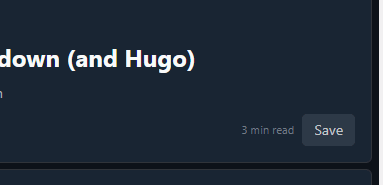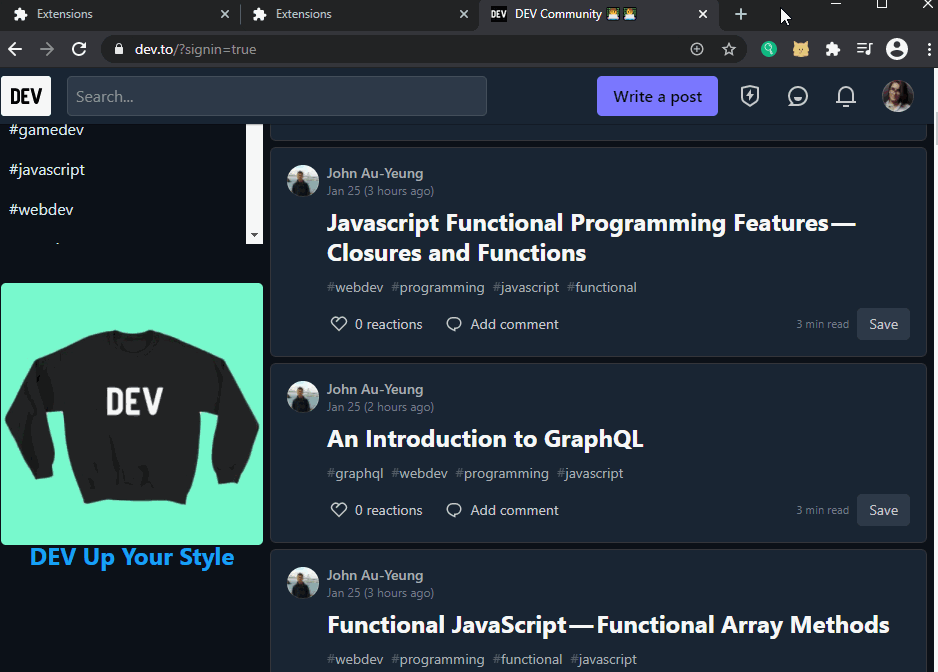In this post, I will focus on content scripts and how to use them to make changes to a web page.
The main concepts we will explore are:
- Using content scripts to make changes to a web page.
- Attaching HTML
- Adding new styles
- Sending messages between the background script and the content script
- Accessing our extension’s resources from the content script
Table of contents
The example
For this post’s example, I will keep adding features to our initial sample extension: We will use content scripts to display a notification at the bottom right of the currently active page. We will also rely on what we learned previously in this series: A command will trigger the notification to be handled by our background script. Finally, the background script will message the content script, to activate the notification showing the title of the page at the bottom-right of the screen:

About content scripts
- Content scripts are files that run in the same context as the web page the user visited.
- They share access with the page’s DOM.
- Within these scripts, we can use JavaScript to access the web page elements, read its contents and make changes. And we can use CSS to add new styles to the web page.
- They allow you to extract information from the page and send it to other scripts or receive messages from our extension.
- Finally, content scripts have access to some of the chrome APIs, which allows us to do stuff like get the current URL, access the extension’s storage, etc.
Let’s get coding!
1. Create a new command
In the previous post of this series, we added two commands to our example extension. Now we are going to add a third one.
To do that, first, we will define the command and it’s suggested shortcut in the manifest.json file:
{
"manifest_version": 2,
"name": "Acho, where are we?",
// ...
"commands": {
"bark": {
"suggested_key": {
"default": "Alt+Shift+3"
},
"description": "Makes Acho bark the title at the bottom right of the current page."
},
// .... Other commands
}
}
Now, we need to handle our command by listening to the onCommand event. This should be done in the background script:
// background.js
chrome.commands.onCommand.addListener(function (command) {
switch (command) {
case 'bark':
barkTitle();
break;
default:
console.log(`Command ${command} not found`);
}
});
function barkTitle() {
const query = { active: true, currentWindow: true };
chrome.tabs.query(query, (tabs) => {
chrome.tabs.sendMessage(tabs[0].id, {
tabTitle: tabs[0].title
});
});
}
So, once the bark command is executed, we will send a message indicating the currently active tab’s title.
Now our content script needs to listen to that message and display the notification.
About Messages: Content scripts don’t run in the context of the extension but in the context of the web page. They need a way to communicating with the extension. We can do that using messages.
- To send a message to a content script, use
chrome.tabs.sendMessageand specify theTabId. The message will be sent to the content script running in that tab.- To send a message from a content script, use
chrome.runtime.sendMessage.
2. Register the content script
To create a content script, the first thing we need to do is (yes, you guessed it!) add it to the manifest.json file:
{
"manifest_version": 2,
"name": "Acho, where are we?",
// ...
"content_scripts": [
{
"matches": ["<all_urls>"],
"js": ["content.js"],
"css": ["content.css"]
}
],
"web_accessible_resources": [
"images/icon32.png"
],
}
content_scripts: An array of content scripts. We can register multiple scripts, each with different configurations.matches: An array of string expressions that specify which pages will this particular content script be injected into. You can use"matches": ["<all_urls>"]to inject it in any URL.js: An array of javascript files. These files will handle the logic for our content scripts.css: An array of CSS files. In this case, we will use a CSS file to define our notification styles.web_accessible_resources: A list of resources we will need to access from our content scripts. Since the content script runs in a different context than the extension, any extension resource we want to access must be explicitly made available here.
3. Display the notification
Let’s start by adding the logic to content.js:
// Notification body.
const notification = document.createElement("div");
notification.className = 'acho-notification';
// Notification icon.
const icon = document.createElement('img');
icon.src = chrome.runtime.getURL("images/icon32.png");
notification.appendChild(icon);
// Notification text.
const notificationText = document.createElement('p');
notification.appendChild(notificationText);
// Add to current page.
document.body.appendChild(notification);
chrome.runtime.onMessage.addListener((request, sender, sendResponse) => {
const notification = document.getElementsByClassName('acho-notification')[0];
const notificationText = notification.getElementsByTagName('p')[0];
notificationText.innerHTML = request.tabTitle;
notification.style.display = 'flex';
setTimeout(function () {
notification.style.display = 'none';
}, 5000);
return true;
});
Now let’s inspect the previous code more carefully:
- First, we create a
div, which will be our notification body. We also assign it aclassthat will help us define styles for it later. - Then, we attach an
imgto the previousdiv. This will add the icon of our extension to the notification box.- To get the icon of our extension, we must use
chrome.runtime.getURL. Remember, the content script doesn’t run in the same context as the extension, so we can’t just access our extension’s resources directly. That’s also why we added theicon32.pngfile to themanifest.jsonas a web-accessible resource.
- To get the icon of our extension, we must use
- Next, we add a
pelement where we will later attach the notification text. - Finally, we append the notification to the web page’s body.
These first 15 lines will ensure that every page loaded has our notification structure. To finally display the notification, we added a listener for the chrome.runtime.onMessage. Let’s inspect that code:
- Once we receive the message, the first thing to do is find the notification’s structure within the current web page. We use
document.getElementsByClassNameto get the notification’s body, and from there we get thepelement inside it usinggetElementsByTagName. - Remember that the message sent by our
background.jsscript includes thetabTitle, so we use that value fromrequest.tabTitleand set it as the content of the notification’s text element. - We make sure our notification is visible by setting the
displayproperty toflex. - Finally, we use
setTimeoutto hide the notification again after 5 seconds.
Great! We are almost done. Let’s add some styles to the notification inside the content.css file:
.acho-notification {
background-color: white;
border: rgb(242, 105, 77) 1px solid;
border-radius: 5px;
font-size: medium;
width: 320px;
display: none;
padding: 8px;
position: fixed;
bottom: 30px;
right: 30px;
align-items: center;
}
.acho-notification > img {
margin-right: 12px;
}
Done!
And that’s it! This is how our notification will look when the user presses Alt+Shift+3:

The repo
I’m keeping this repo updated with all my Chrome Extensions examples: